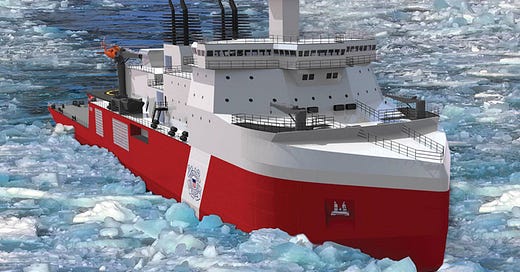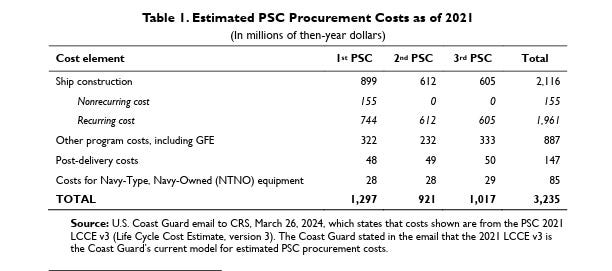USCG Polar Security Cutter Program: Additional Delays and Higher Costs Projected
More details on the woes of the U.S. Coast Guard's Polar Icebreaker Program are expected this week.
Quick Recap on the Polar Security Cutter (PSC) Program
The U.S. Coast Guard (USCG)-Navy Intergrated Program Office awarded the contract for detail design and construction of the first Polar Security Cutter (PSC) to VT Halter1 more than five years ago, on April 23, 2019. Delivery of the lead vessel was scheduled for March of 2024. The contract included an option for a total of three of these vessels; the USCG exercised the option for a second in December of 2021. The contract incentivized early delivery, and there was some hope within the USCG that they would receive the first PSC as early as late 2023.
Schedule Slip to 2029
One of these days I’ll go through and list all of the schedule slips, but today we will just look at the latest. In July of 2023, following a General Accountability Office (GAO) report, the projected delivery date of the first PSC slipped into 2028, although there was little confidence in that date (year). In Congressional testimony from just a few months earlier (April 2023) the Commandant of the Coast Guard, Admiral Linda Fagan, declined to even say in which decade Congress should expect delivery of the lead ship. (See minutes 29-33 in the below video).
On week ago, on April 29, 2024, Ronald O’Rourke updated his Congressional Research Service (CRS) report on the Polar Security Cutter Program. Here’s what changed from the previous (March 27, 2024) version (differences in bold).
March 27, 2024 (page 20):
If construction of the first ship begins in 2024, and if the ship takes at least four years to build, which might be a reasonable estimate for building a lead ship (i.e., first ship in the class) of the PSC’s size and complexity, then the first PSC might be delivered no earlier than 2028.
April 29, 2024 (page 20):
If construction of the first ship begins in 2024, and if the ship takes five years to build, which might be a reasonable estimate for building a lead ship (i.e., first ship in the class) of the PSC’s size and complexity, then the first PSC might be delivered no earlier than 2029.
So 2029 it is, at least for today. The other changes in the most recent version amount to replacing the 2028 delivery date with 2029 in each instance. Mr. O’Rourke must know something that we don’t (at least not yet). Perhaps he will tell us tomorrow.
What about cost?
In my April 5th post, I noted that the March 27th version of the CRS report on the PSC program updated the cost estimates for the first three PSCs:
Although the new information is based on 2021 data, CRS did not get this “update” until March 26, 2024 (see the “source” information on the bottom of the chart).
This is a more than 500 million-dollar increase from the projection cited in the January 2024 report. This “updated” projection dates all the way back to 2021. With all of the identified challenges identified by outside entities such as the GAO and Congressional Budget Office (CBO) since then, how far off might that 2021 cost estimate be?
According to the CBO, it could be off by sixty percent, with much of the increased cost driven by a nearly 40% increase in the USCG’s estimate of the ship’s lightship displacement. In other words, the ship has gotten bigger throughout the detailed design phase. In advance of his testimony scheduled for tomorrow before the House Subcommittee on Transportation and Maritime Security, Dr. Eric J. Labs of the Congressional Budget Office released a short summary of the upcoming CBO report on the Polar Security Cuter Program, focusing on cost estimates:
• The procurement cost of the first PSC would be about $1.9 billion. Subsequent ships would average about $1.6 billion each. (All costs in this statement are expressed in 2024 dollars.)
• Given those costs, the procurement cost of three PSCs would be about $5.1 billion. That amount is 60 percent greater than the Coast Guard’s most recent publicly released estimate for the procurement cost of three heavy icebreakers, which was provided to CBO by the Coast Guard in March 2024.
The full report should be published sometime this summer.
Let’s quickly take a look at the initial projected cost of these three vessels:
Yes, you’re reading that right. The cost has nearly doubled. If you go back to the 29:25 mark of the video above, you will hear the Commandant of the Coast Guard say that the program is “on budget and on contract.” SMH.
And the Actual Construction?
In August 2023, to great fanfare, Bollinger shipyards began actually cutting steel for the first PSC:
Bollinger Shipyards LLC (“Bollinger”) has begun cutting steel at Bollinger Mississippi Shipbuilding in Pascagoula, MS on the first of eight prototype modules that will become the foundation of the first U.S. Coast Guard Polar Security Cutter (PSC), USCGC Polar Sentinel (PSC-1) – the first heavy icebreaker to be built in the United States in 50 years.
“Today marks a significant step for both Bollinger Shipyards and the United States,” said Ben Bordelon, President and CEO of Bollinger Shipyards. “After over 50 years, we’re back to building heavy icebreakers. We’re honored that responsibility lies with Bollinger. Beginning work on the first Prototype Fabrication Assembly Unit is an important step closer to commencing construction on the first Polar Security Cutter. This isn’t just an important milestone for our company, it’s also an important step for our national defense. Simply put, the United States is back in the icebreaker business.”
…
Each module requires approximately four months of labor, during which time Bollinger will continue recruiting and training additional members of the workforce to manage the transition to production of the lead hull as the prototype modules are completed.
According to a gCaptain, article from March 2024, it’s not going well:
“As of this month, unit 1 is approximately 42% complete; unit 2 is approximately 27% complete, and unit 3 is approximately 5% complete,” the Coast Guard elaborated.
Each Polar Security Cutter consists of a total of 85 modules.
The progress update puts into a new light comments by the Coast Guard about currently devising a new program schedule.
“The Coast Guard is working with the shipbuilder to rebaseline [the program], which will result in a new program schedule. This is expected to be completed later this year and will be critical to informing future budget requests,” the spokesperson told gCaptain.
gCaptain reported that four modules were authorized for work in July of 2023. Work began in August (per the above-cited Bollinger press release), with work on each module projected to take four months. Now, more than seven months after steel cutting began, the furthest along of the four modules is just 42% complete.
Tomorrow’s Hearing of the Subcommittee on Transportation and Maritime Security
I will be watching tomorrow’s hearing, at which the witnesses will include Ron O’Rourke and Dr. Eric Labs, authors of the CRS and CBO reports mentioned above, as well as a representative from the GAO. I will be very interested in hearing the Coast Guard’s scheduled witnesses, VADM Paul Thomas, Deputy Commandant for Mission Support, and Randolph “Tex” Alles, the Undersecretary for Management, Department of Homeland Security.
Over time, as the PSC delays mounted and costs increased, the USCG gradually warmed to alternative proposals that it had once rejected, such as acquisition of a commercially available polar icebreaker. Perhaps USCG leadership will begin warming to other ideas also previously rejected, such as increased cooperation with foreign shipyards or the long-term lease or purchase of foreign vessels. I don’t really expect any earth-shattering news, though- just confirmation that there is little confidence in the current budget and schedule outlook.
I will report on the hearing later this week.
Until then, thanks for reading, subscribing, and spreading the word.
Like by pressing the heart if you want to see more posts like this, and please consider sharing with a friend or seven.
All the Best,
PGR
The shipyard where VT Halter is building the PSCs was acquired by Bolllinter Shipyards in November of 2022, with Bollinger taking over the PSC contract.









One HUGE part of cost overruns; changes to the design after construction has begun.